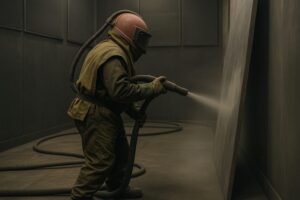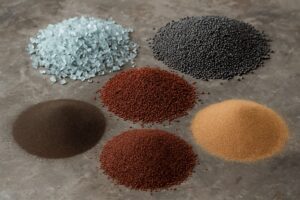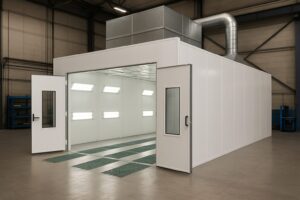When it comes to surface preparation, sandblasting is one of the most effective techniques around. Whether you’re removing rust from metal, prepping a surface for paint, cleaning parts, or giving something a new texture, sandblasting gets the job done fast and efficiently. But not all sandblasting jobs are the same, and neither are the materials used to carry them out.
The key to successful sandblasting lies in choosing the right abrasive. Each abrasive type has its own unique strengths, and using the right one can make the difference between a smooth finish and a costly mistake. If you’re not sure which abrasive suits which job, you’re not alone. In this post, we’ll walk you through the most popular types of abrasives used in sandblasting and which applications they’re best for.
Why Abrasive Choice Matters
Before diving into the different abrasives, let’s quickly talk about why your choice matters. Abrasives vary in hardness, shape, weight, and reusability. These factors directly affect how they impact the surface you’re blasting. Using the wrong abrasive can damage the material, make the job longer than it needs to be, or lead to poor results. So understanding the right match for the right job helps save time, money, and headaches.
Crushed Glass: A Go-To for General Cleaning
Crushed glass is one of the most common abrasives out there, and for good reason. It’s made from recycled glass, so it’s environmentally friendly, and it’s sharp enough to cut through rust, scale, and old coatings effectively. Crushed glass is best used on surfaces that require a relatively gentle touch compared to harder abrasives—think car parts, metal panels, or machinery that needs paint stripping without warping.
Its angular shape creates a nice profile on metal surfaces, which helps new coatings stick better. Plus, it’s silica-free, making it a safer option for operators. If you’re dealing with a typical repaint job or want to prep something without roughing it up too much, crushed glass is a solid choice.
Aluminum Oxide: Tough Jobs Meet Their Match
If you’re working with tougher materials or need to cut through hard coatings, aluminum oxide is your go-to abrasive. It’s incredibly hard and durable, which makes it perfect for demanding sandblasting applications like removing heavy rust, paint, or corrosion. Aluminum oxide works well on metal, stainless steel, and even some stone surfaces.
One of the major perks is that it’s reusable. You can recycle aluminum oxide several times before it breaks down, making it more cost-effective in the long run—especially in a controlled blast booth setting. It also creates a rougher surface profile, ideal for applications where a strong bond is needed, such as industrial coating or powder coating.
Garnet: The Cleaner Finish
Garnet is a natural mineral abrasive that’s prized for its clean-cut finish. It’s less aggressive than aluminum oxide but still packs enough punch to clean steel, aluminum, and other hard surfaces. What sets garnet apart is its ability to produce less dust, which makes for a cleaner workspace and better visibility during the blasting process.
If you’re doing indoor blasting or working on a job where cleanliness and precision are key, like prepping tanks, bridges, or delicate machinery, garnet might be the abrasive you want. It’s also reusable, and because it breaks down into finer particles instead of jagged pieces, it’s less likely to damage the substrate.
Steel Grit and Steel Shot: For the Heavy-Duty Jobs
Steel grit and steel shot are the heavy hitters of the abrasive world. These metallic abrasives are ideal for large-scale, industrial-grade applications, like cleaning structural steel, removing scale from foundry castings, or prepping surfaces for heavy-duty coatings.
Steel grit has a more angular shape, which makes it better for etching and creating surface profiles. Steel shot, on the other hand, is round and is used more for peening or polishing, where the goal is to strengthen a metal surface rather than aggressively remove material.
Both are reusable many times over, which offsets their higher initial cost. They’re also best used in blast rooms or automated systems where recovery and recycling can be managed efficiently.
Walnut Shells: Gentle but Effective
Not every sandblasting project calls for brute force. Sometimes you need something much gentler, especially when working with soft metals, wood, or delicate molds. That’s where walnut shell abrasives come into play. These organic abrasives are biodegradable, low-dust, and surprisingly effective at cleaning without harming the underlying surface.
They’re especially popular for cleaning engine components, removing graffiti, or restoring antique wood or fiberglass. You won’t get a heavy profile from walnut shells, but that’s the point—they clean without cutting, making them ideal for projects that need a light touch.
Plastic Media: Ideal for Aerospace and Automotive
Plastic media is another great abrasive when the goal is surface cleaning without material removal. It’s commonly used in the aerospace and automotive industries, where removing paint from delicate surfaces without harming the base material is critical. Think aircraft panels, car bodies, or even sensitive molds used in manufacturing.
Because plastic media is lighter and softer than mineral abrasives, it won’t warp thin metal or leave harsh edges. It’s often used in dry stripping processes and in applications where precision and surface integrity are essential.
Baking Soda (Soda Blasting): Non-Destructive Cleaning
Yes, baking soda is more than just a kitchen staple. In the world of sandblasting, sodium bicarbonate can be used as a gentle abrasive for delicate surfaces. It’s great for removing grease, oil, mold, and even smoke damage without damaging surfaces like glass, chrome, or soft metals.
Soda blasting is commonly used in automotive restoration, fire damage cleanup, and food industry equipment cleaning. It’s non-toxic, water-soluble, and won’t leave a profile on the surface, making it more of a cleaning method than a preparation technique.
Making the Right Choice
So, which abrasive is best? It depends on the job. If you’re prepping a metal panel for repainting, crushed glass or aluminum oxide may be your best bet. Working with delicate materials or restoration work? Walnut shells or baking soda are the safer options. For industrial applications where surface profile and toughness are critical, steel grit or garnet will deliver.
It’s also important to factor in safety, cost, and environmental impact. Reusable abrasives like aluminum oxide and steel shot may cost more upfront but save money over time. Meanwhile, eco-friendly options like crushed glass and walnut shells support sustainable practices.
Final Thoughts
The right abrasive can transform how effective and efficient your sandblasting work is. In a paint booth setting, where surface prep is key to the final result, making a smart choice on abrasives sets the stage for success. Whether you’re cleaning, stripping, or preparing for coating, understanding which media suits which task is a skill every technician and project manager should have in their toolbox.
Choosing the best abrasive isn’t just about power’s about precision, purpose, and getting the best results with the least amount of waste. So next time you’re loading up your blast cabinet or prepping a project, take a moment to consider what you’re using—and whether there’s a better choice for the job.
Specialized Sandblasting Booth Services
We specialize in providing top-quality sandblasting booths and custom finishing solutions tailored to meet the unique needs of various industries. Our expert team designs and manufactures state-of-the-art sandblasting booths that ensure safety, efficiency, and superior performance. From automotive and aerospace to marine and industrial applications, our booths are engineered to handle even the most demanding surface preparation tasks. We offer comprehensive services, including booth installation, maintenance, upgrades, and technical support.




